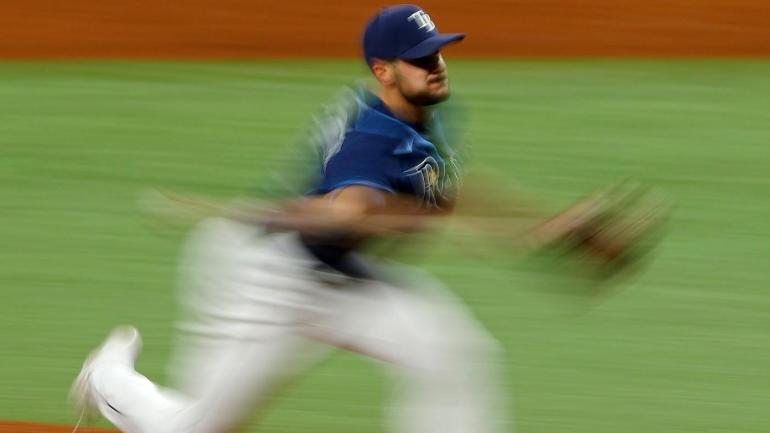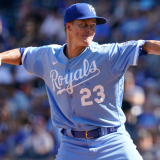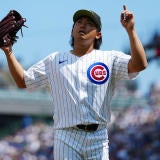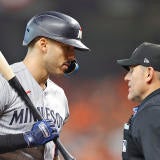
With a victory against the New York Yankees on Thursday night, the Tampa Bay Rays will advance to their first American League Championship Series since 2008 -- or, the same year they reached the World Series. Before the Rays can concern themselves with securing the second pennant in franchise history, they'll have to notch another win against the Yankees. If the Rays are to punch their ticket on Thursday, they'll do so behind a most unexpected starter: Ryan Thompson, a 28-year-old rookie right-hander, is expected to get the nod as an opener.
Thompson's name is unlikely to register with many outside of the Tampa Bay region, and for good reason. This is his second season with the Rays organization, having joined the club through the Rule 5 draft's less-publicized minor-league phase in the winter of 2018. Thompson, who was recovering from Tommy John surgery at the time, was the 18th pick in the Triple-A section, and one of four Tampa Bay selections overall. He spent last season primarily in Double-A, where he was nearly three years older than his average competition.
The Rays liked what they saw from Thompson, and he made their Opening Day roster this summer. In 25 appearances (one open) he posted a 4.44 ERA and a 2.88 strikeout-to-walk ratio. Those marks aren't impressive, but Thompson is more interesting than they suggest. To wit, let's highlight three things to know about him and what the Yankees can expect Thursday night.
1. Thompson has an extreme release point
Tampa Bay has collected pitchers with oddball approach angles, either horizontally or vertically, over the last several years. In that regard, Thompson is a fit. He's a true sidearmer who releases the ball close to his beltline. If that didn't create enough havoc for right-handed batters, he also stands on the extreme third-base side of the rubber.
As a result, Thompson's release point is the fifth-farthest-in to right-handed hitters, and the fifth-closest to the ground. (Aaron Loup, a veteran lefty in the Rays bullpen, is essentially Thompson's mirror.)
| Pitcher | Team | Horizontal Release Point (inches) |
|---|---|---|
-48 | ||
-43.5 | ||
-40.9 | ||
-40.4 | ||
Ryan Thompson | Rays | -40.2 |
Do note that the negative number in the table above means, simply, that the release point is toward the third-base side. A positive number would indicate that the release point is toward the first-base side.
2. Thompson's slider is his best pitch
Thompson isn't a trick pitcher, either. His fastballs sit in the low-90s and they can bump 94 mph, which doesn't make him the Aroldis Chapman of sidearmers but does give him more oomph than the standard fare. He also has a sweeping slider thrown at a curveball speed. Of those two offerings, the slider is more effective. Opponents hit .375 against his heat, compared to .196 (with a 34 percent whiff rate) against the offspeed stuff. Thompson did use his four-seam fastball more down the stretch, suggesting he could offer three looks to hitters on Thursday night instead of his standard two.
3. Thompson is bait
Given everything above -- the extreme release point, the effective slider -- you might think Thompson is lethal to right-handed hitters. He wasn't. Manager Kevin Cash did use him that way, however, with Thompson owning the platoon advantage in nearly 70 percent of his matchups. Right-handers still hit .284/.321/.473 against Thompson, albeit with some positive underlying indicators that suggest he's better against righties than that slash line: a 5.00 strikeout-to-walk ratio and a lower average exit velocity than what lefties mustered.
The Yankees tend to have a right-handed-heavy lineup, but knowing Thompson will open the game could tempt Aaron Boone into inserting some of his lefty-hitting reserves. That could prove to be a mistake, seeing as how Thompson is unlikely to be around for long. On average, he faced 4.56 batters per outing, but that number was inflated by some early-season appearances. In September, arguably a truer barometer of his use, he faced three batters or fewer in five of his 10 games, and faced more than five batters a single time -- in his first outing of the month.
Boone would be wise, then, to keep in mind that the Rays' primary outgetter, for the game and even for the first half of the contest, won't be Thompson; instead, it's likely to be Ryan Yarbrough, a southpaw who is tougher on left-handed hitters. If Boone does fall victim to overestimating Thompson's stay in the game, Cash would likely use Loup and Oliver DRake, one of the league's only right-handed left-handed specialists, as counters.
The Yankees saw for themselves in Game 2 how the opener strategy isn't a silver bullet for a pitching staff. The key is maintaining perspective and not falling into a well-laid trap.






















